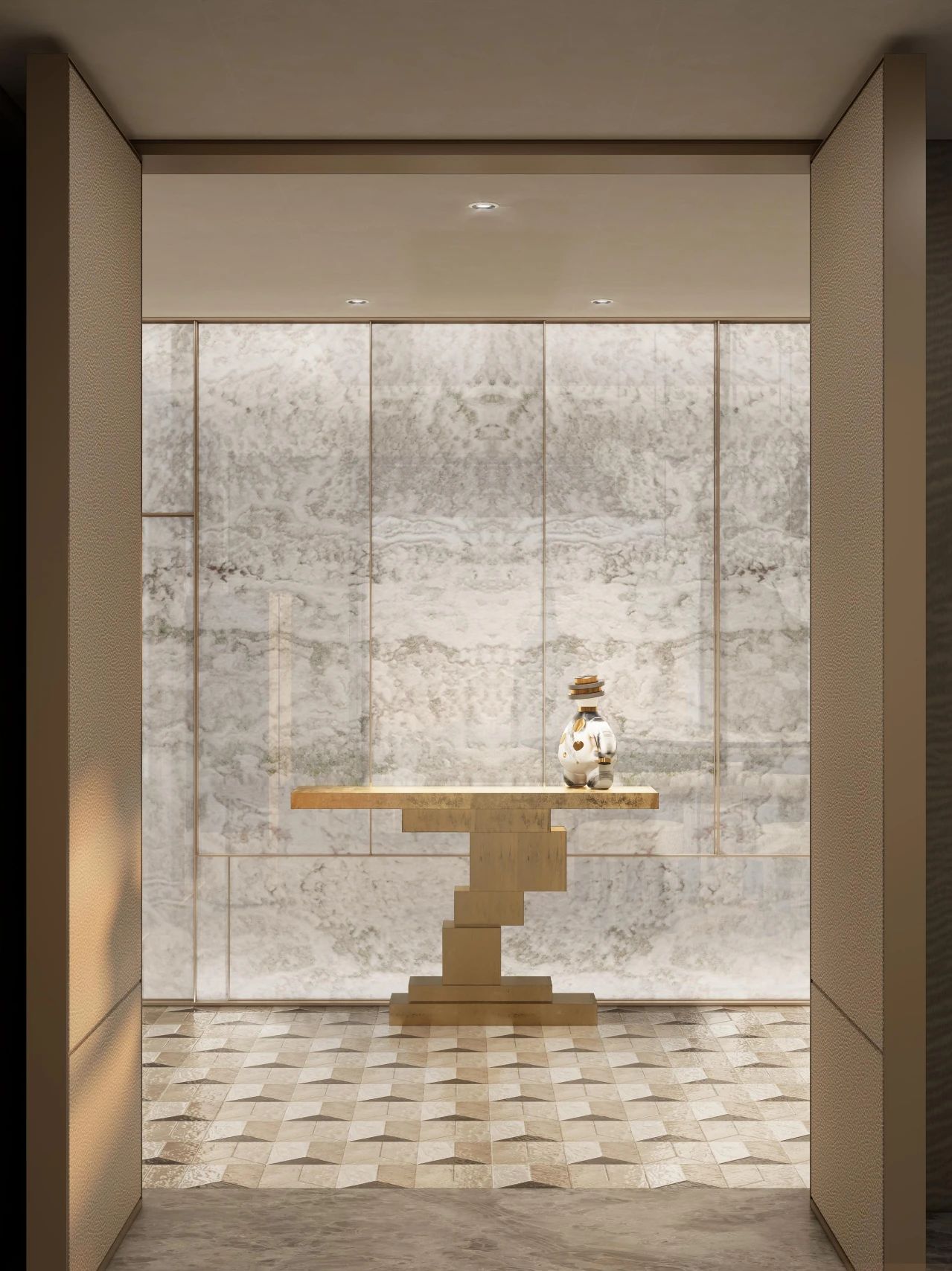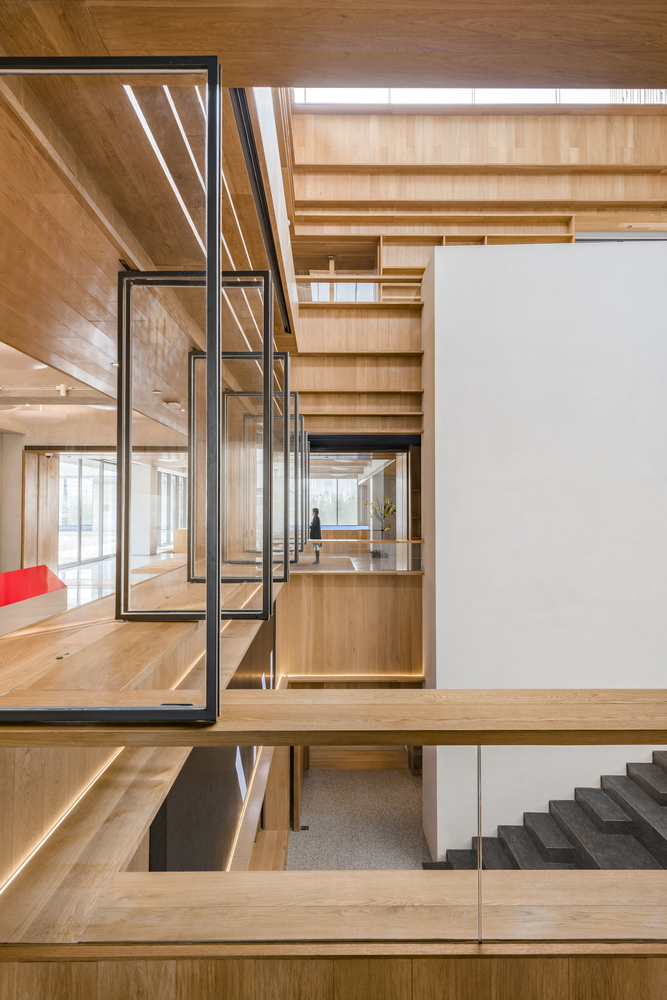CoBLOgó SUBdV
2017-08-05 09:00
架构师提供的文本描述。在巴西圣保罗的这家工厂和办公附件中,采用了“高-低”融合,其中从国外引进的高科技建筑设计策略与当地的低技术建筑方法相结合,创造了一种“热带化”的数字美学。采用参数化设计、数字环境模拟和数字制造为低技术劳动力设计和编写教学指南,使用简单的本地材料建造参数旋转的混凝土砌块幕墙,以及定制的数字制造家具和内墙面板。
Text description provided by the architects. For this Factory and Office Annex in São Paulo Brazil, a ‘high-low’ fusion was employed, where high-tech architectural design strategies imported from abroad were combined with local low-tech construction methodologies to create a ‘tropicalized’ digital aesthetic. Parametric design, digital environmental simulation, and digital fabrication were employed to design and prepare the instructional guides for a low-tech labor force using simple local materials to construct a parametrically rotating concrete-block façade screen, as well as custom-made digitally fabricated furniture and internal wall panels.
该建筑的总体意图是提供一个经济的,环境敏感的,但新颖的设计,使现代工业身份的工厂综合体。在圣保罗市工业郊区Tabo o da Serra的一家现有工厂前面,附属大楼在一个分层的场地上建造了各种项目。双高地下空间包括一个新的机械化装载原材料储存设施,第一层和第二层专门为工厂提供行政办公空间,最后一层是工厂产品展厅。
The overall intent of the building was to provide an economical, environmentally sensitive, yet novel design to give a contemporary industrial identity to the factory complex. The annex building houses various programs on a split level site in front of an existing factory in the São Paulo industrial suburb of Taboão da Serra. The double-height ground floor space contains a new mechanized-loaded raw material storage facility, the first and second floors are dedicated to administrative office space for the factory, and the final floor is a show-room for factory products.
这是巴西第一次使用数字设计和制造技术建立基于组件的外观系统。参照巴西传统的“cobogo”遮阳屏,这种环境下的“第二层皮肤”控制着通过南面和西面可操作的窗户过滤间接阳光,同时也创造了一个热质量,防止热空气进入室内空间。新附件的北侧与现有的工厂大楼相连,而东面部分由树木和邻近的墙遮阴,并向盛行的风向开放,这样空间就可以交叉自然通风。因此,室内空间是凉爽的,沐浴在一个明亮的,扩散的自然光,突出了现象学发挥的阴影和光在循环空间在下午后期。
This is the first time in Brazil that a differentiating component-based façade system is built using digital design and fabrication. In reference to the traditional Brazilian ‘cobogo’ shading screen, this environmental ‘second skin’ controls the filtration of indirect sun-light through the operable windows on the south and west facades, while also creating a thermal mass which prevents the penetration of hot air in the interior spaces. The north side of the new annex is connected to the existing factory building, while the east façade is partially shaded by the trees and neighboring wall, and open to prevailing wind directions which allow for a cross natural ventilation of the space. The interior space is thus cool and bathed in a bright diffused natural light highlighted by a phenomenological play of shadow and light along the circulation spaces in the late afternoon.
参数计算既用于生成不同的几何配置以创建不同的环境性能场景,也用于构造外观本身的方法。参数脚本产生不同旋转角度的细微梯度,由它们与不同的“吸引点”的距离控制。这就产生了不同大小的开口和不同角度的光反射面,并使用数字环境模拟方法进行了测试,以产生阴影和照度的最佳组合。在最初的设计过程中,采用了数字制造来生产各种模型和原型,以开发不同的结构和制造方案。
Parametric computation was used for both the generation of various geometric configurations to create different environmental performance scenarios, as well as for a method to construct the façade itself. The parametric scripts generated subtle gradations of varying rotation angles of the blocks, controlled by their distance from different ‘attraction points’. This thus generated different sized openings and differently- angled light reflection planes, which were tested using digital environmental simulation to generate the best combination of both shading and illuminance. Digital fabrication was employed throughout the initial design process to produce various models and prototypes to develop different structural and fabrication options.
为了用与数字模型相同的旋转方式在现场安装混凝土块,一个参数化的脚本创建了梳状的“指南”来定位这些块,这些块是由激光切割瓦楞纸板制成的。这些指南被放置在一个可移动的木材支架和轨道系统,该系统是由胶合板制成的,使用的是数控路由器。混凝土砌块石匠只需将砌块靠在导轨上,并在每一其他砌块中添加垂直钢筋,连接在底部和顶部混凝土板上,即可获得结构稳定。
To mount the concrete blocks on site using the same rotations as those in the digital model, a parametric script created comb-like ‘guides’ to position the blocks, which were made by laser-cutting corrugated cardboard. Theses guides were placed on a moveable wood stand and track system that were fabricated of plywood using the CNC router. The concrete block mason only had to position the blocks against the guides and add vertical reinforcing bar in every other block, attached to the bottom and top concrete slabs, to obtain structural stability.
这种将参数化设计和数字制造与现场简单的建筑技术和材料联系起来的制造工艺说明了“高-低”的过程,SUBdV建筑师通过他们在巴西指导的建筑协会参观学校讲习班期间所做的实验,将其应用于各种建筑和研究项目。这种将“高技术”方法(参数计算和数字制造)与“低技术”建筑方法和廉价的本地材料(在这种情况下是混凝土块)结合起来的过程,可以“美化”数字设计,并为数字设计提供一个新的、关键的巴西身份,以避免当代参数美学日益普遍和普遍的质量。同时,立面还说明了SUBdV建筑师以前研究过的另一个概念:“环境装饰”,即立面上的装饰品不再仅仅被视为装饰,而是成为产生特定环境表现的有用元素,从而为建筑文化创造了一种新型的“功能美学”。采用参数化计算和数字制造技术,为办公室设计了装饰性墙板、楼梯护栏和家具。数字设计的穿孔墙板和护栏是为了吸收新办公布局的开放式规划中的声音,同时也为工业单色混凝土结构和墙壁提供多色和纹理的美学。所有的墙板和护栏,以及家具的部件都是用数控路由器切割的,并详细地使用了数控铣削盒接头,避免了金属硬件的使用,从而创造了一种有趣的审美。这些表的设计采用了一个双面布置,中间有一个用于电缆的嵌入式通道,还有一个中央分隔板,用于用户之间的隐私保护。
This fabrication process that links parametric design and digital fabrication to simple construction techniques and materials on site illustrates the process of ‘HIGH-LOW’, which SUBdV architects have applied on various building and research projects through experiments made during the Architectural Association Visiting School workshops, which they direct in Brazil. This process of combining ‘high-technology’ methodology (parametric computation and digital fabrication) with ‘low-technology’ construction methods and cheap local materials, (in this case the concrete blocks), can ‘tropicalize’ and give a new and critical Brazilian identity to digital design, to escape the growing ubiquitous and generic quality of the contemporary parametric aesthetic. At the same time, the façade also illustrates another concept that has been studied previously by SUBdV architects: that of ‘environmental ornamentation’, where ornament on a façade is no longer perceived as merely decoration, but becomes a useful element to produce a specific environmental performance, thus creating a new type of ‘functional aesthetic’ for building culture. Parametric computation and digital fabrication were used to create decorative wall panels, stair guard-rails and the furniture for the office. The digitally designed perforated wall panels and guard-rails were conceived so to absorb sound in the open-plan of the new office layout, and to also give a multi-colored and textured aesthetic to the industrial monochromatic concrete structure and walls. All the wall panels and guard rails, as well as the components of the furniture were cut using the CNC router, and detailed with CNC milled box-joints, avoiding the use of metal hardware, thus creating a playful aesthetic. The tables were designed with a two-sided arrangement with an embedded channel in the middle for electric cables, and central dividing panels for privacy between users.
Location Rod. Régis Bittencourt, 272 - Centro, Taboão da Serra - SP, Brazil
Photographs Rodrigo Chust
Category Institutional Buildings
 举报
举报
别默默的看了,快登录帮我评论一下吧!:)
注册
登录
更多评论
相关文章
-

描边风设计中,最容易犯的8种问题分析
2018年走过了四分之一,LOGO设计趋势也清晰了LOGO设计
-

描边风设计中,最容易犯的8种问题分析
2018年走过了四分之一,LOGO设计趋势也清晰了LOGO设计
-

描边风设计中,最容易犯的8种问题分析
2018年走过了四分之一,LOGO设计趋势也清晰了LOGO设计










































































